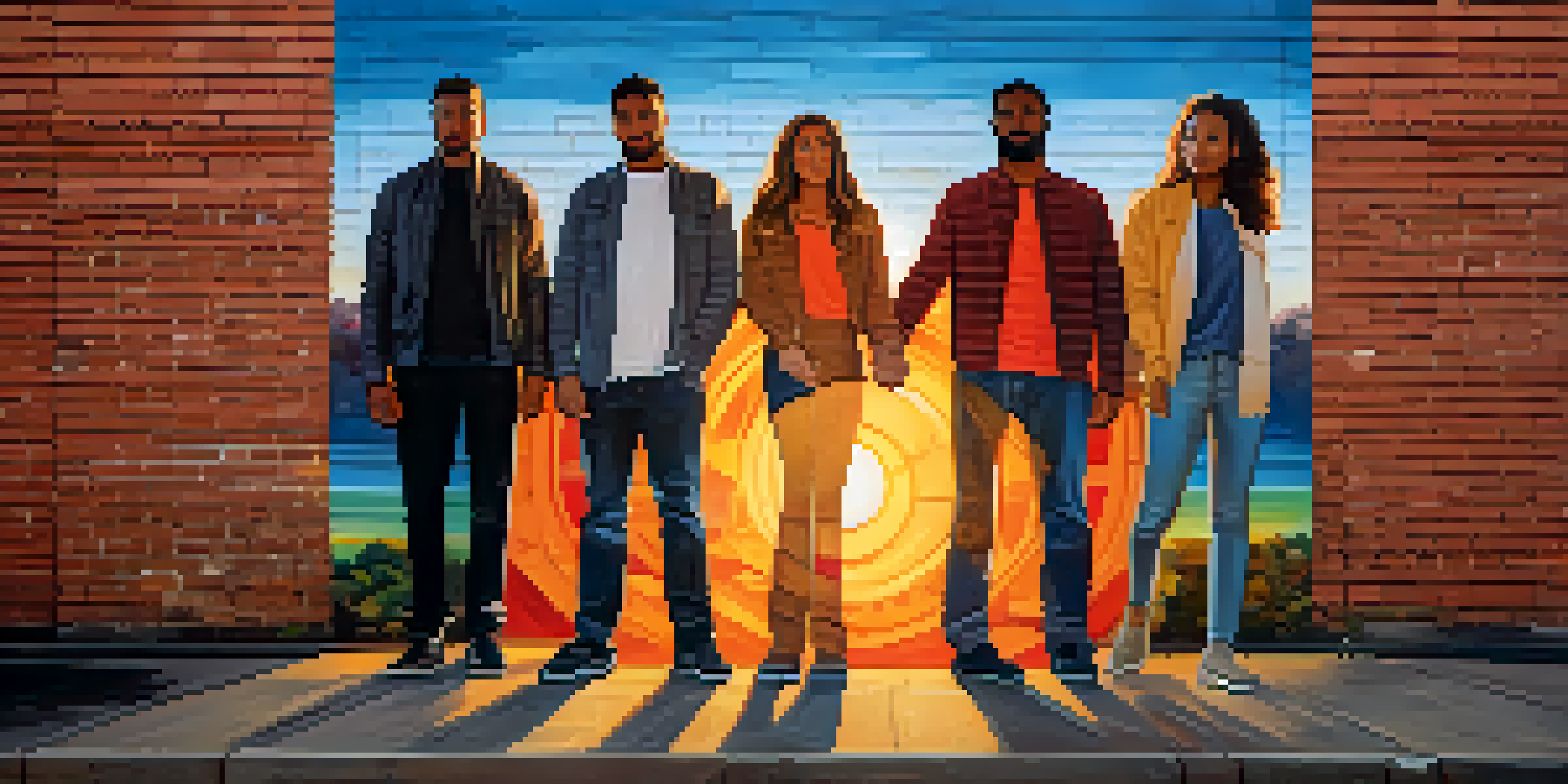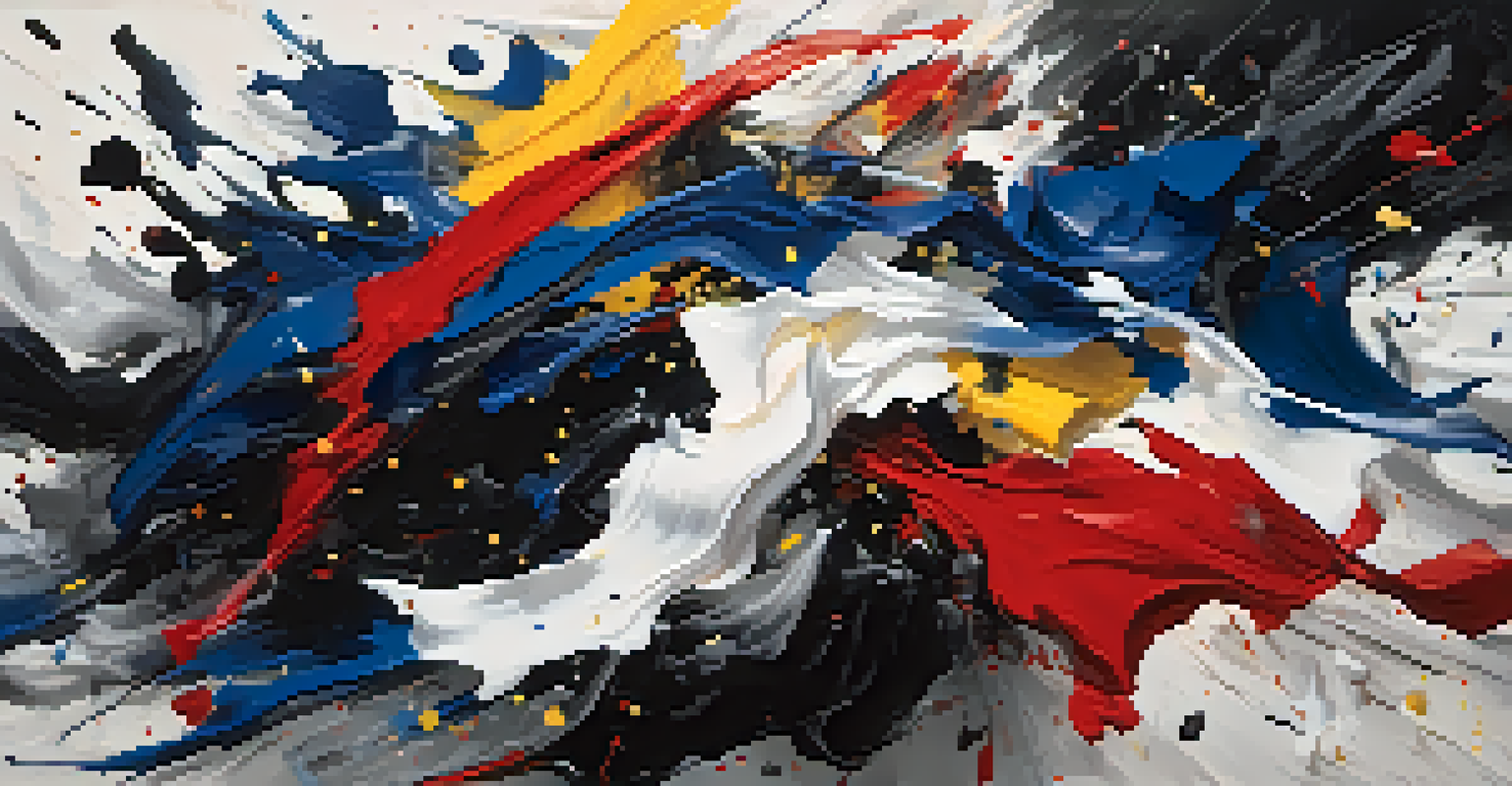Artistic Responses to War: Paintings of Protest and Resistance

The Power of Art as a Form of Protest
Art has long served as a powerful medium for expressing dissent, especially during times of conflict. Artists use their creativity to voice opposition to war, highlighting its devastating impact on humanity. Through various forms, such as paintings, murals, and installations, they capture the emotional depth of suffering and resistance experienced by individuals and communities.
Every artist dips his brush in his own soul, and paints his own nature into his pictures.
For example, Pablo Picasso's 'Guernica' starkly depicts the horrors of the Spanish Civil War, embodying the pain and chaos of war through its dramatic imagery. This artwork not only protests against the violence but also serves as a historical document, reminding viewers of the consequences of war. Such pieces resonate beyond their time, urging society to reflect on the past and consider the future.
In essence, art transforms personal anguish into a collective message, fostering a sense of solidarity among those who oppose war. It invites dialogue, encouraging viewers to confront uncomfortable truths and engage in discussions about peace and resistance.
Historical Context: Art in Times of War
Throughout history, wars have profoundly influenced artistic expression. From the trenches of World War I to the protests of the Vietnam War, artists have responded with works that challenge prevailing narratives. This historical context not only shapes the themes of their art but also reflects the societal attitudes towards conflict during those times.

For instance, the Russian avant-garde movement emerged during the tumult of the Russian Revolution, using art as a means to advocate for change. Artists like Kazimir Malevich and El Lissitzky embraced abstraction to convey revolutionary ideals. Their works were not merely aesthetic; they aimed to inspire action and reflect the hopes of a new society free from oppression.
Art as Protest Against War
Art has historically served as a powerful medium for expressing dissent and raising awareness about the devastating impacts of conflict.
Understanding these historical contexts enriches our appreciation of the art produced during war. It highlights how artists have continually adapted their messages to resonate with the experiences of their contemporaries, making art a vital instrument for protest and reflection.
Iconic War Paintings and Their Messages
Some paintings have become iconic symbols of anti-war sentiment, transcending their original contexts. Edward Munch's 'The Scream,' for example, while not about war specifically, conveys a universal sense of anxiety and despair that can be felt in times of conflict. Such works invite viewers to contemplate the human condition amid turmoil.
Art is not freedom from discipline, but disciplined freedom.
Another powerful example is Francisco Goya's 'The Third of May 1808,' which captures the brutal execution of Spanish rebels by French soldiers. Goya's raw portrayal of fear and suffering serves as a timeless reminder of the consequences of war and the loss of innocent lives. This painting has become emblematic of the horrors of conflict, prompting viewers to reflect on their moral responsibilities.
These iconic pieces resonate with audiences long after their creation, illustrating how art can transcend time and remain relevant. They serve not only as historical records but also as enduring calls for peace and justice.
Modern Artistic Responses to Contemporary Conflicts
In today's world, artists continue to respond to ongoing conflicts through their work. Issues such as terrorism, refugee crises, and the consequences of globalization inspire contemporary artists to create powerful pieces that address these pressing concerns. Their art often serves to raise awareness and foster empathy among viewers.
For example, the work of contemporary artist Ai Weiwei addresses the plight of refugees through poignant installations and exhibitions. His art challenges viewers to confront the realities faced by displaced individuals, transforming abstract statistics into human stories. This approach encourages a deeper understanding of the complexities surrounding modern conflicts.
Healing Power of Art
Beyond protest, art provides therapeutic benefits that help individuals and communities cope with trauma and rebuild identities in times of war.
By engaging with contemporary issues, artists not only document the current state of the world but also inspire action and change. Their work acts as a bridge between the present and the past, reminding us that the struggle for peace and justice is ongoing.
Art as a Healing Force Amidst Conflict
Beyond protest, art also serves as a means of healing in times of war. For many, creating or experiencing art can be a therapeutic process, helping individuals cope with trauma and loss. This aspect of artistic expression can foster resilience and promote emotional recovery, both personally and collectively.
For instance, community murals created in war-torn regions often embody messages of hope and unity. These collaborative efforts allow individuals to express their experiences and aspirations, transforming spaces of despair into symbols of strength. Such artworks can play a crucial role in rebuilding communities and restoring a sense of identity.
In recognizing the healing power of art, we can appreciate its multifaceted role in society. It not only protests against injustice but also nurtures the spirit, offering solace and inspiration in the face of adversity.
The Role of Art Institutions in Promoting Anti-War Art
Art institutions play a significant role in fostering dialogue around war and peace through exhibitions and programming. Galleries, museums, and cultural organizations often curate shows that highlight anti-war art, creating platforms for artists to share their perspectives. This promotes awareness and encourages public engagement with critical issues.
For example, the Museum of Modern Art (MoMA) has showcased works that respond to war, emphasizing the importance of art as a tool for social change. By providing visibility to artists addressing conflict, these institutions help to cultivate a broader understanding of the human experience during wartime.
Role of Institutions in Art
Art institutions play a crucial role in promoting anti-war art, facilitating dialogue, and fostering public engagement with critical societal issues.
Additionally, art institutions can facilitate discussions and workshops that empower communities to explore their own experiences with war. By making art accessible and relevant, they foster a culture of resistance and resilience, enriching the public's connection to these vital conversations.
The Future of Artistic Expression in a Changing World
As the world continues to grapple with conflict, the future of artistic expression remains vibrant and essential. New technologies and mediums are emerging, offering artists innovative ways to communicate their messages. From digital art to virtual reality experiences, the possibilities for engaging with themes of war and resistance are expanding.
Moreover, the increasing interconnectedness of global communities allows for a diverse range of voices to be heard. Artists from different backgrounds and cultures can collaborate, sharing their unique perspectives on conflict and resilience. This cross-pollination of ideas enriches the artistic landscape and fosters a deeper understanding of the complexities of war.

Looking ahead, art will undoubtedly continue to play a crucial role in shaping societal narratives around conflict. By embracing innovation and inclusivity, artists can inspire future generations to engage in the ongoing struggle for peace and justice.